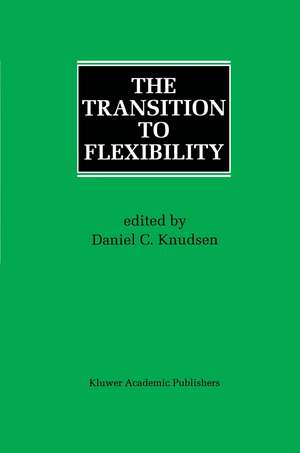The Transition to Flexibility
Editat de Daniel C. Knudsenen Limba Engleză Hardback – 31 oct 1996
The book is a collection of papers by well-known scholars investigating the current global transition from mass consumption and production to flexible production for niche markets. The book is unique in that it not only discusses standard economic concerns, but also investigates the social and political implications of this transition. Each chapter is concerned with a different aspect of the same restructuring process.
| Toate formatele și edițiile | Preț | Express |
|---|---|---|
| Paperback (1) | 635.80 lei 6-8 săpt. | |
| Springer Us – 27 sep 2011 | 635.80 lei 6-8 săpt. | |
| Hardback (1) | 642.03 lei 6-8 săpt. | |
| Springer Us – 31 oct 1996 | 642.03 lei 6-8 săpt. |
Preț: 642.03 lei
Preț vechi: 755.33 lei
-15% Nou
Puncte Express: 963
Preț estimativ în valută:
122.85€ • 128.59$ • 102.25£
122.85€ • 128.59$ • 102.25£
Carte tipărită la comandă
Livrare economică 01-15 aprilie
Preluare comenzi: 021 569.72.76
Specificații
ISBN-13: 9780792397601
ISBN-10: 0792397606
Pagini: 204
Ilustrații: XIV, 186 p.
Dimensiuni: 155 x 235 x 17 mm
Greutate: 0.46 kg
Ediția:1996
Editura: Springer Us
Colecția Springer
Locul publicării:New York, NY, United States
ISBN-10: 0792397606
Pagini: 204
Ilustrații: XIV, 186 p.
Dimensiuni: 155 x 235 x 17 mm
Greutate: 0.46 kg
Ediția:1996
Editura: Springer Us
Colecția Springer
Locul publicării:New York, NY, United States
Public țintă
ResearchCuprins
1 The Current Transition in Industrial Capitalism.- Transitions in Industrial Capitalism: A Regulationist Approach.- Fordism.- A New Method of Production?.- In the Sequel.- References.- 2 Technology, Competitiveness, and Flexibility: Constantly Evolving Concepts.- Technology.- Competitiveness.- Flexibility.- Flexible Places.- Conclusion.- References.- 3 Labor and Capitalist Accumulation in the Late Twentieth Century: What and Who is Flexible?.- Traditional U.S. Labor Relations.- The Japanese Production System.- The New Knowledge Worker in America.- The Non-Think Workers.- The Concept of Flexible Accumulation Reconsidered.- Endnotes.- References.- 4 Preparing Workers and Students for the New Workplace.- Basic Skills Demands of the New Workplace.- Basic Skills Levels of Current Employees.- Current School Practices and Student Abilities.- Promising Developments in School and Workplace Education.- Summary.- References.- 5 Large Firm Strategies: Spatial Patterns of Production.- Views of National Economic Development.- Views of Firm Evolution.- Géographes of Production in Large Firms.- Conclusion.- References.- 6 Services and Flexible Production: Contingent But Mutually Reinforcing Systems.- What Are Services?.- Forces Driving the Growth of Services.- Flexibility and the Externalization of Services.- The Digital Revolution and the Changing Geography of Producer Services.- Concluding Thoughts.- References.- 7 Inter-Firm Collaboration and Industrial Competitiveness.- Basic Changes in the World Eocnomy.- The Importance of Adding Value.- The Dimensions of Modernization.- Modernization and Public Policy.- 8 Government Response to Structural Change and the Implementation of More Flexible Management and Production Systems.- Background.- The Policy Context.- Specific PolicyChallenges.- Conclusions.- Endnotes.- References.- 9 Fixed Structures in Transition: The Changing Demand for Office and Industrial Infrastructure.- Milwaukee: A Traditional Industrial City.- Office Infrastructure.- Industrial Infrastructure.- Redevelopment Challenges.- Fixed Structures in Transition: Summary and Prognosis.- Endnotes.- References.- 10 Period and Place, Capitalist Development, and the Flexible Specialization Debate.- The Nature of Capitalist Development in Time and Space.- The Contemporary Conjuncture.- Concluding Comments.- References.- 11 The Current Transition Reconsidered.- Summary of the Essays Contained in the Book.- Conclusions.- References.














